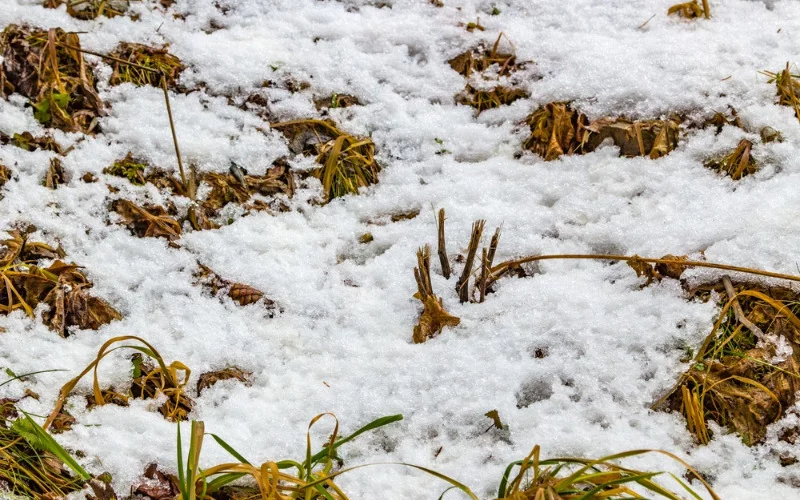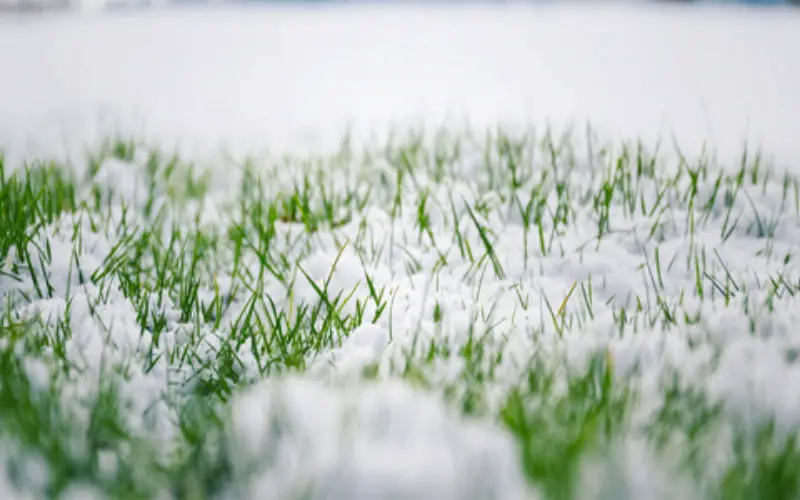Weeds are a real nuisance in our lawns and gardens because not only do they compete with our beloved plants for space and nutrients, but they can take over our space and make it look untidy while providing shade for rodents insects, and even smaller wild animals to hide.
Many people believe that these weeds die out with the winter, this may be true for some weeds, but others can stand the cold and frost and even thrive.
There are a lot of things that can eradicate weeds in winter, from spraying them with herbicides to manually pulling them out. There is no better time to kill that weed in your garden or lawn than in winter.
Do Weeds Die in the Winter
The fact that it’s winter doesn’t mean that all the weeds are dead and so you have no weeding to do in your lawn or garden.
Even though the weather is chilly, some weeds can survive in it. Hence, if the question is asked if weeds die in the winter, our answer will be partly Yes and partly no.
Weeds are a little like humans in planning, so when you feel like these weeds are dying because of the cold, they already have plans to come back in full force after the winter.
Like most plants, weeds during winter go into dormancy, or they slow down their growth circle a bit, and this is what many confuse to be that the weeds are dead.
So on the periphery, it seems as if they are dying because the shoots and leaf blades of these weeds die off, but they leave their seeds in the soil, and these seeds have a protective shell that keeps them immune from the cold.
So, the weeds are dead, but the seeds are left in the soil, and they can stand the harshest condition.
Some of these seeds are so hardy that they remain unaffected by even some of the weed control measures you might adopt, including the use of herbicides.
So once the winter is over, the snow is all melted, and the weather becomes favorable again, you see these weeds reappear in full force, it those seeds in the soil that have germinated to overrun your lawn or garden.
Do Weeds Die With Frost?
Most weeds wither and die in the frost, just like most plants; however, some weeds manage and survive in freezing temperatures. These are winter weeds that can stand very low temperatures.
Annual bluegrass is a winter grass that is very invasive and can stay for weeks under ice and snow and still come out alive.
Clover and dandelion are other such examples of weeds that can survive frost; even though they lose their foliage, they manage to sprout again in spring from their roots and not from their seeds like other weeds.
What Kills Weeds in the Winter?
Winter is a good time to kill the weeds you have around you because, at this time, they are more vulnerable to herbicides.
There are, however, some dormant weeds that are quite resistant to weed killers; hence you have to resort to a winter weed treatment to kill those weeds completely.
You start first by identifying the weeds in your lawn or garden to know the best way to kill them. Many chemicals will prove very efficient in killing these weeds.
Knowing the kind of weed you are dealing with is a lot easier to pick the best herbicide to kill it because some herbicides are more effective than others.
Isoxaben and atrazine are very popular chemicals used in killing winter weeds because of how effective they are.
Other herbicides work well in caring for winter weeds, especially the broadleaf weeds and winter annuals. One of them is Tenacity, which works well on post-emergent weeds.
Another great product that will kill winter weeds is BioSafe, an organic herbicide that has the advantage that it does not leave any residue in the soil after it is applied.
What Kind of Weeds Die in the Winter?
The winter annuals are the only weeds that truly survive in winter. These weeds drop their seeds in fall, and these seeds shrivel in winter, but the weeds themselves stay alive all through winter before they die in warmer months.
If nothing is done to the seeds they leave behind, they will germinate in spring, and the weeds will reemerge.
Summer weeds that germinate and grow during the summer are the weeds that die in winter. This type of weed includes Crabgrass, Yellow Foxtail, Fall Panicum, Witchgrass, Goosegrass, and Sandbur. They usually die after 6 to 12 months.
Why Do Most Weeds Die in Winter?

The chilly winter temperature has the same effect that cold has on plants and weeds alike. For weeds to stay alive, they need an optimum growth environment, especially in terms of temperature, sunlight, water, air, and the likes and in winter, these elements are not fit for most plants to grow in, even for weeds, which is why a lot of them die.
Do Weeds Come Back Every Year?
Yes, weeds keep coming back every year. Understanding the different types of weeds will help you understand why weeds keep reappearing yearly despite all your weed management activities.
Weeds can be classified in so many ways, but one of the major classifications is based on when and how long it takes them to mature; based on this, weeds can be classified into:
1. Annual weeds
These are weeds that grow, mature, and then produce seeds and eventually die in one year or less.
This is to say that these weeds can complete their life cycle in one year. These weeds are a lot easier to control when they are still seedlings.
Annual weeds are divided into two main types.
a. Summer Annuals:
These are annual weeds that germinate late in winter or even early in spring, they grow a lot faster in the warmer months, and by the end of summer, they die after producing seeds.
b. Winter Annuals:
These are weeds that germinate in late summer or early fall, and they mature in winter, and these weeds can thrive in these very cold winter months. An example of these weeds is henbit. These weeds produce seeds in warmer months and then die off.
2. Biennial Weeds
These are weeds that complete their life cycle in 2 years. An example of such weeds is primrose. These weeds germinate and grow in the first year, while they produce seeds and flowering stalks in the second year.
Afterward, these weeds wither and die, and hence new weeds begin to form from the seeds, and the 2-year cycle continues.
3. Perennial Weeds
Perennial weeds are plants that live or complete their life cycle in more than two years. They might stay for more than two years without producing seeds; they keep growing.
Dandelions are an example of perennial weeds; the roots store food for the winter so that even if they can’t photosynthesize much in winter, they still have enough to keep it alive. Perennial weeds are the most difficult to kill because they can spread without producing seeds.
So you see, there are different weeds, and it is almost impossible to completely eradicate all of them because they have different life cycles. Some can withstand winter, and hence they will keep reappearing every year.
How Do I Get Rid of Weeds in My Lawn in the Winter?
Weeds are very complex plants, and they are quite resilient too, so if you are thinking of ways of killing those pesky weeds in your yard, you should be very proactive in your approach.
It is important to note that not all measures you take to get rid of weeds in summer will work in winter because of the chilly weather.
Below are some ways of getting rid of weeds in winter:
Use Herbicides
You can apply herbicides to the soil before or after the seeds germinate. Using herbicides should only be done at the onset of winter for the herbicides to be effective. If you want to apply herbicide to kill weeds, then you have to do the following:
a. The soil should be watered for about 48 hours before the herbicide is applied. The soil should not be mowed during this time.
b. Then spray the herbicide onto the growing weeds but not onto the soil directly because you do not want the soil to be saturated with chemicals that will affect the soil structure and nutrients of the soil afterward.
c. Then leave the soil like that for about 24 hours after applying the herbicide without watering it because, within this time, the chemical is still effectively dealing with the weeds. Watering the lawn or garden will wash off some of these chemicals.
Spread Mulch:
Mulch has a way of determining the growth of weeds. You should spread half an inch of mulch over the soil; this mulch layer will keep sunlight from penetrating the soil so that the seeds of these weeds cannot germinate.
This mulch has a lot of advantages for the plants; for starters, it helps the soil retain its moisture because it reduces the evaporation rate of water from the soil. It also provides nutrients for the plant as it decomposes slowly into the soil.
Manual Removal
You can pull out weeds from your lawn or garden with your hands if they are not many. Before you start pulling out the weeds, you should water the garden or lawn a little, so it is soft enough for the weeds to be pulled out easily.
The trick is to put the weeds from the root and not just tear it out because if the roots are left in the soil, they can still sprout shoots later. You can use a gardening fork to pry out the roots of very stubborn weeds.
Trim the Garden Edges
If you can trim the edges of your lawn or garden properly, you are on your way to killing the weeds in your lawn or garden. Most lawnmowers do not clear all the grasses at the edges of the garden because, in most cases, they can’t get to it, and this is where some weeds remain, and they spread their seeds to all the other parts of the garden or lawn.
Conclusion
Weed is one of the biggest issues you have with gardening, farming, and keeping your lawn because they are unwanted plants that grow in places they are not wanted hence the need always to eradicate them.
Some weeds die in winter, but they leave their seeds behind, which quickly resurface after winter to invade the lawn and garden again.
However, there are very effective chemicals and herbicides that are effective against these weeds, and one of the most effective of them that is environmentally friendly is BioSafe.
Helpful Links:
- What To Put Under Rocks To Prevent Weeds?
- Can You Dethatch St. Augustine Grass?
- How to Get Rid of a Tree Stump With Charcoal
- How Do You Rot a Tree Stump Naturally?
- How To Cut Grass Without a Lawnmower (6 Creative Ways)
We trust this article helped you know why Weeds Die in the Winter. You may also want to check out How To Kill A Tree Stump Fast.
Thanks for taking the time to read our article, and we hope you find it helpful. Would you mind leaving a comment below if you have any suggestions?
Kindly reach out to people by sharing this post on social media.
If you liked this article, then please follow us on Facebook, Instagram, and Pinterest.

